Perspective and Patience
In a previous piece I wrote about last season’s most penalised players in European domestic league rugby, in which props proved themselves to be extraordinarily popular at the top of the charts. Is this the same in Super Rugby?
Tim Horan, former Wallaby back and now TV commentator, had said during commentary of the season’s first Bledisloe Cup encounter that referees wouldn’t be too pedantic when it came to the enforcement of the straight feed. Perspective is all-important and when it comes to the source of Horan’s view it’s worth asking if things were different down under.
Using the same methodology as before, here’s the top of the Super Rugby charts when it comes to penalties conceded per 80 minutes last season.
A quick recap:
– Pro 12: 23 of the top 27 were front rows
– Premiership: 25 of the top 28
– Top 14: 28 of the top 30
Super Rugby: 18 of the top 29 are front rows.
But Super Rugby teams play far fewer games than, say, the Top 14, so perhaps that’s misleading. Ok. Let’s knock down Super Rugby’s 200 minutes minimum to 150 minutes and see where it gets us…
Super Rugby (minimum 150 minutes played): 20 of the top 29 are front rows.
A move from 18 to 20 (of 29) is a bit of a nudge but hardly a monumental shift. Recall that across all European domestic competition every one of the top 35 most penalised players was a front row. In the case of Super Rugby there’s an indication that front rows were less often villainised in Super Rugby compared to those in the Northern Hemisphere club game, at least where this rough and ready measure is concerned.
This becomes clearer when one simply looks at props alone and their rate of conceding penalties in each competition:
That’s a big difference between Super Rugby and the Northern Hemisphere club competitions, especially those in England and France. Is this Horan’s different perspective?
After all, it still holds when one adds international rugby to the fold, small number of games (and thus the increased chance of a fluke) notwithstanding. The Six Nations leaps to the top of the charts with the Rugby Championship slotting in a tiny bit below Super Rugby.
Is there something else at work here? For example, is the number of scrums in an average Southern Hemisphere contest vastly different?
In the Rugby Championship this was certainly the case with an average of 13 scrums per game compared to 17 in the Top 14, with the decrease in opportunities for scrum penalties that go along with that.
However, in Super Rugby there were more scrums per game than the Six Nations or the Premiership.
Penalties per scrum, however, tells a very clear story.
The average Super Rugby match might have had more scrums than one in the Premiership but the sight of two front rows packing down at Sale or Leicester was almost twice as likely to end in a penalty as one in Melbourne or Cape Town.
Note that this doesn’t even take free kicks into account; to do so reveals that in the 2013 Six Nations one in every two scrums ended with a referee awarding a free kick or penalty compared to one in every four in Super Rugby and under one in three in the Rugby Championship.
Perhaps it’s now possible to get a better idea of the perspective from where Tim Horan’s comment on pedantry might have come. Maybe the scrum just didn’t seem so much of an issue.
The new engagement process will undoubtedly lead to frustration among players, coaches and referees as they try to drag the scrummage back from the gates of hell. As part of this, a law of the game is now being enforced after years of being ignored.
To some, this is pedantry.
To others, it heralds the return of a long-mourned part of rugby union that makes it the wonderful game it is.
And it will need patience.
Credit: raw player data courtesy of Opta
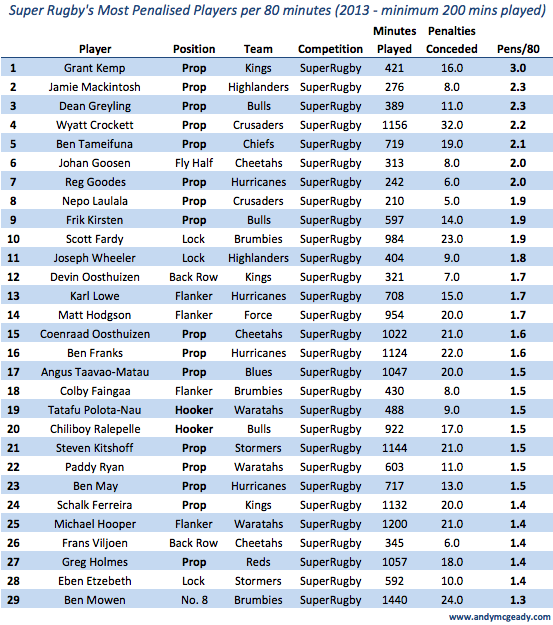
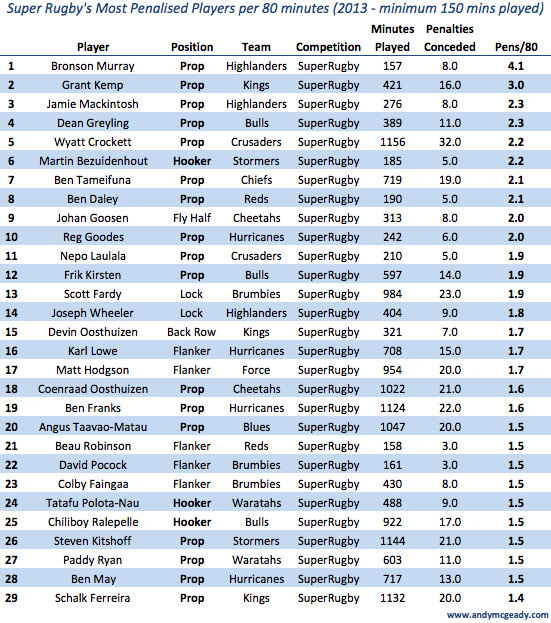
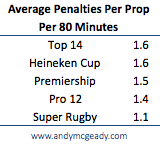
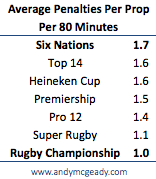
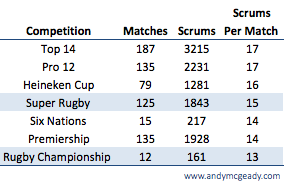
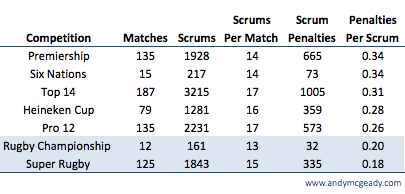
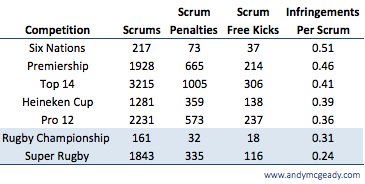

Fair play to Johan Goosen as a fly half making it into the top 10 penalty machines. Anyone know what his particular penalty peccadillo is? Don’t watch SH rugby so don’t know much about him.
Mr. Goosen’s rap sheet…
3 offside
1 not rolling away
1 not releasing
1 wrong side
and a couple more for fun
Reasonably diverse. Seems like he likes to mix it up.